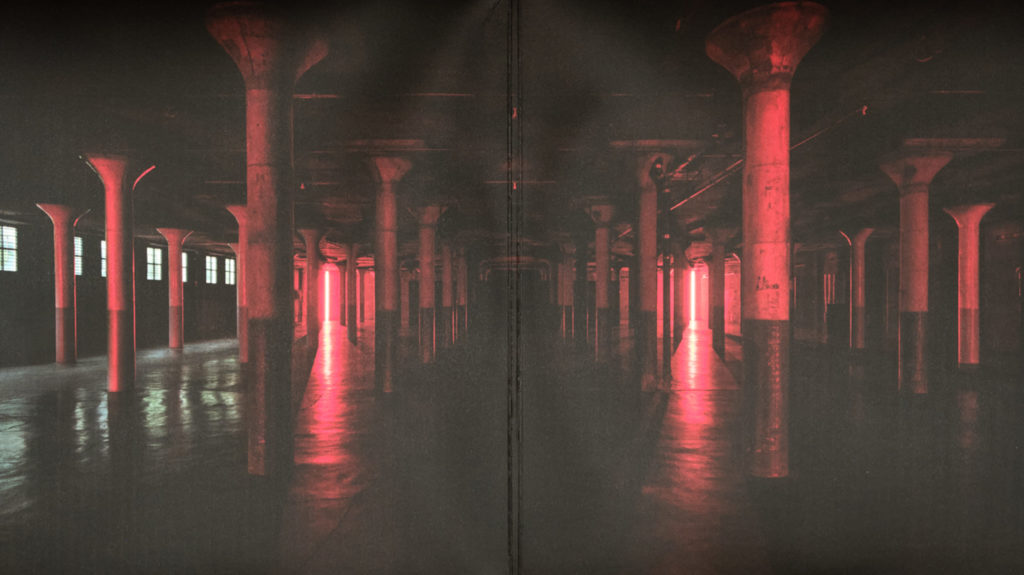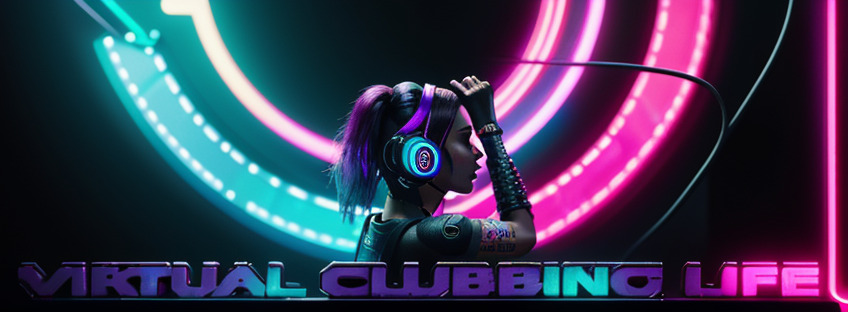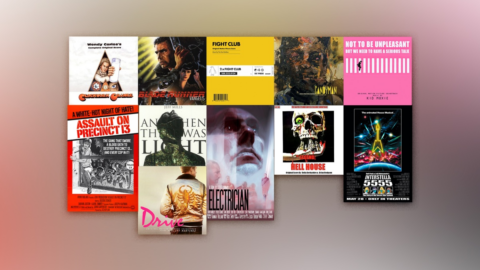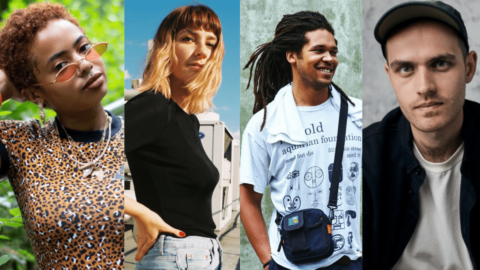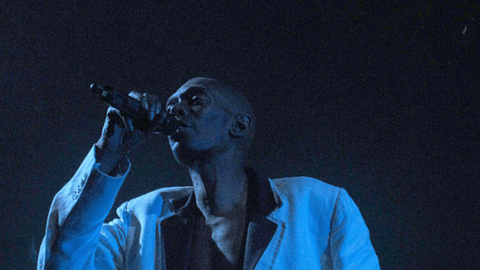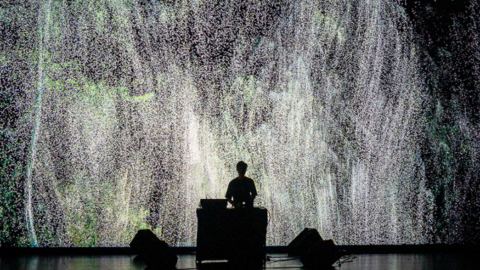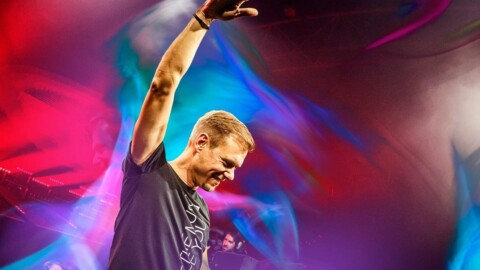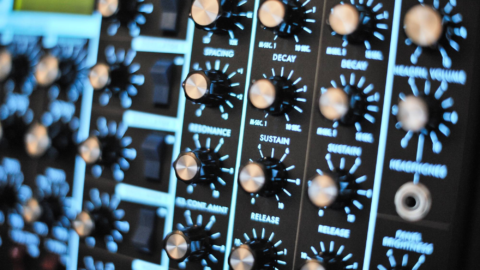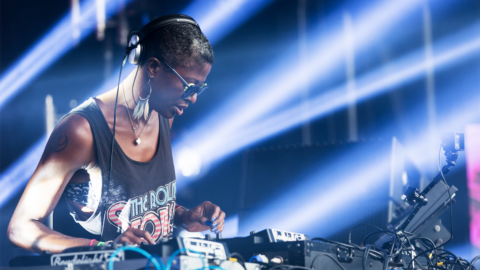Above the Fold
Read time
Text by
Following Carl Craig’s ‘Party/After-Party’ record signing at Art Basel Miami Beach, the pioneering DJ and art advisor discuss how visual and sonic experimentation will inform our future
It was years ago that DJ Carl Craig and art advisor Nazy Nazhand first asked a question: How do you take the philosophy of techno, and bring it into a fine arts context? This was the beginning of the collaboration that brought Craig’s art installation, Party/After-Party, into being.
A leading figure in the Detroit techno scene, Craig has spent his career at the vanguard of sonic exploration—pulling from diverse influences to expand the boundaries of the genre, and creating experiences larger than the sum of their parts. The same is true of his approach to fine art: With Party/After-Party, which premiered at Dia Art Foundation in 2020, Craig mined his personal experience as a DJ to create an artwork in collaboration with the historic institution. “True to techno’s commitment to the humanization of the machine aesthetic, Craig created a contemplative space built on the politics of the form—one that empowers counter-histories, reclamation, and imagined futures,” writes curator Kelly Kivland of the project.
Staged in the lower level of Dia Beacon—a warehouse that formerly served as a factory for Nabisco boxes—the piece sees Craig mine both his personal experiences and the radical history of techno to create an immersive sound installation that is, despite the cavernous setting, surprisingly intimate. Inspired by the solitary comedown he experiences after performing, the soundtrack to Party/After-Party seems to expand and contract, echoing the ringing of tinnitus in Craig’s ears—a condition brought on by the harsh physical reality of performing the craft he loves. “With the installation, I wanted to create the feeling that you walk in before the party starts—you have an anticipation of what is going to happen. And instead of your idea of what an afterparty looks like, it’s the experience I have at the end of the night,” he says, speaking of the dissonance between the communal catharsis of the dance floor and the loneliness that follows “It’s a big part of my experience as a DJ, and part of what makes the work feel like me.”
According to Craig, techno has always been about imagination. “It wasn’t over Patrón shots at the club, but in Detroit’s bedrooms and abandoned factories, where techno first harnessed urban decline and discontent to imagine possible future worlds,” Craig told Document in 2020.
The ability to envision new futures has been equally essential to Nazhand’s work: “As a curator and art advisor, a big part of what I do is see things that aren’t yet there, and ask, How do you bring that to life?” she says. Known for initiating a dialogue between visual arts and other disciplines, Nazhand helps creatives bring ambitious, boundary-pushing projects to fruition—from Craig’s Party/After-Party to Land of Dreams, a feature film by contemporary artist Shirin Neshat.
Lately, Nazhand has been channeling this ability to explore the intersection of two enduring interests: art, and electronic music. “Contemporary art pushes boundaries—and the same is true of electronic music, with the creation of new sound,” she muses. “Decades ago, if music was not performed on a guitar, with an orchestra, or a drum, people were asking, Is that music? We hear the same thing in the art world—people asking, Is that art?”
The result of years of collaboration with both Nazhand and Dia, Party/After-Party was born—and its impact resonated far beyond the museum’s walls. The installation is now slated to travel to MOCA Los Angeles, where it will be re-staged for its new environment. It’s also been commemorated in a two-disc vinyl set, recorded live at the museum. At this year’s edition of Art Basel Miami Beach, Craig and Nazhand joined forces once again to throw a vinyl-signing party in celebration of the release—a laid-back but exclusive occasion that attracted acclaimed artists and creatives, ranging from fellow musician and DJ Richie Hawtin to artist Miles Greenberg to designer Daniel Lee.
For Document, Craig and Nazhand reunite to discuss how this marriage of visual and sonic experimentation will inform our creative future.
Camille Sojit Pejcha: Nazy, you helped realize Carl Craig’s work at Dia Beacon. Can you describe the process of bringing his musical practice into the fine arts space?
Nazy Nazhand: Carl was in a five-year engagement with Dia Art Foundation before [he created] that work. When he saw the basement, that’s when the real dialogue began—the question of, how do you capture the philosophy of techno, which is taking over abandoned spaces for radical experimentation, and bring it into a fine arts context?
Carl Craig: I wanted to make sure that whatever I made was an extension of the kind of work I do as a musician. When Miles Davis got older and stopped doing so much music, he took up painting—the same is true of George Clinton.
Especially coming from the Midwest, people have this locked-in idea of what they think art is. For many people, art is always something that they’ve seen before: If you paint a pot of flowers, then that’s recognized as art. And I didn’t want to walk into the situation, and be like, I’m gonna be Carl Craig the painter now; I didn’t want to do that at all, because I don’t feel that represents me, or my life, or my vision.
Nazy: For many years, I had been exploring ways to bring together the medium of electronic music and the work of contemporary artists. As a curator and art advisor, a big part of what I do is see things that aren’t yet there, and ask, How do you bring that to life?
Carl: For me, the eureka moment was when I was sitting with the curator Kelly Kivland. We were at Soho House, and the DJ was playing, and I had the thought that this is my life, and it should be the subject of the piece. My job is playing at warehouses and empty clubs—and the basement at Dia was the perfect place to show the experiences of my life that people don’t always recognize, because they have a certain idea of what being a DJ is, in the same way that people have an idea of what an artist is.
I don’t remember ever hearing the word ‘no’ uttered to me from Dia. And I think that helped me to maximize on doing something interesting with the piece.
Camille: Can you speak a little to the intersection between electronic music and fine art—the similarities and differences, and how the two inform each other?
Nazy: As someone who appreciates both worlds, and who’s had the privilege of intimate access to both, the first thing that comes to mind is the idea of new mediums. This is the case with contemporary art, because it pushes the boundaries. Does it have to be a still life of a painting that’s considered art, or can it be performance, video, conceptual art, the written word? I think the same is true of electronic music, with the creation of a new notion of sound. Electronic musicians are some of the most brilliant engineers, taking different sounds and then creating whole new worlds from them. Decades ago, if music was not performed on a guitar, with an orchestra, or a drum, people were asking, Is that music? We hear the same thing in the art world—people asking, Is that art?
“Decades ago, if music was not performed on a guitar, with an orchestra, or a drum, people were asking, Is that music? We hear the same thing in the art world—people asking, Is that art?”
Camille: Can you speak to the site-specific nature of Party/After-Party—how the architecture inspired the installation?
Nazy: The space was so important, because it’s about the history of techno taking over abandoned buildings for experimentation and performance. But then to also stage this as a site-specific installation within an institution like Dia, and now MOCA, demonstrates how these two worlds—art and techno—are properly speaking to each other in both a historical context. Carl was really able to bring that together, and the work resonated with audiences and museum-goers on such a broad scale that it was acquired by Dia Art Foundation—one of the most incredible art spaces in the world, and part of a group of institutions that historically acquires a certain type of artist and a certain type of work.
So you have this incredible validation, that the work belongs in a permanent collection of the museum. And then it’s traveling, so now the work is being lent from Dia to MOCA. Carl’s engagement with the space will be completely unique—the sound will echo differently, the music will resonate differently.
Camille: It’s been said that Party/After-Party speaks to both the euphoria of the club environment and the collective comedown and loneliness that can follow that. Can you share a little more about this?
Carl: It was intended to subvert expectations. With any party, you think you’re going to walk in and it’s going to be full—there’s going to be people dancing on tables, and drinks all around. And then with the afterparty, you’re thinking that all your friends are coming back to a place where everybody’s going to keep on partying.
With the installation, I wanted to create the feeling that you walk in before the party starts—you have an anticipation of what is going to happen. And instead of your idea of what an afterparty looks like, it’s the experience I have at the end of the night: sitting alone in my hotel room, my ears ringing, not being able to find anything good on TV, and hearing voices coming from all different parts of the room. That informed the experimental sound, because these are my experiences as a DJ, and what makes this work feel like a part of me. If I’m going to do anything creative, it’s got to be about me putting my experiences down, including all the emotions that go into that.
Camille: This particular work took on a new significance in the context of the pandemic. Do you feel that your own relationship with these environments and the collective experiences that you’re touching on in the piece have changed radically as a result?
Do you think people are kind of finding catharsis on the dance floor, or in collective environments, in different ways now?
Carl: You know, I really did think that as a result of the pandemic, there was a possibility for the underground to become underground again. But it seems like we’re back to business as usual—the festivals are opening up or have opened up, and the same artists are being booked like it was before the pandemic. I really felt that there was going to be more local talent that was going to explode in these places, because you couldn’t travel—but unfortunately, the economy makes it hard for underground parties to be something great.
Camille: The practice of taking over abandoned factories is central to that history. What came to mind for you when you first saw the space, and how did it inspire the nature of the sound installation?
Carl: It’s a warehouse, an old Nabisco factory. We know factories in Detroit, because we’re a car city, and the practice of taking over abandoned spaces is central to techno. Dia took a factory and maximized it. Here, the mentality to take a factory like the Packard Plant and turn it into a modern art museum just isn’t there—we have the money to do it, we just don’t have the mentality.
When we were figuring out how we were going to do this at Dia, the idea of staging it in Chelsea came into the mix. But that didn’t make any sense to me, because in New York City, the concept of taking over a warehouse has been done in the same way that it’s been done in London, the same way it’s been done in Detroit, the same way it’s been done anywhere else. Doing it in Beacon is different, where they have a waterfall around the block, and a train goes past at 15 minutes after the hour, every hour, and it’s got all this beautiful scenery—there, you can walk in to hear the thump of the sound, and I think it makes a stronger impact than it would if you were walking in from the noise and bustle of the city.
Camille: Do you feel like the spirit of what brought you into these creative worlds has evolved or changed much over the course of your career, or is it just taking on different forms?
“I think that the human hand, in art, is the one thing we cannot fully remove. But the artist’s hand can be digital, as long as there is a human mind behind it.”
Carl: I’ve always been interested in architecture, and how people use space.
Growing up going to the Detroit Institute of Arts, I always went to the contemporary part of the collection. It’s funny, because I had grown up seeing the work of people like Donald Judd and Dan Flavin, but I just didn’t know what it was. And then I end up at Dia, and think, Fuck, I remember this from when I was a kid. I’ve had a great career where I can kind of walk into situations and realize I’ve experienced them firsthand—I was already living with the work [of the] the people who established it and pioneered it. It’s amazing. I’ve had that with music, too, like when I worked with Leon Ware, who was part of Motown. We did a tour, and I realized I actually know all of his music, because I grew up with it. He was writing for Marvin Gaye and Minnie Riperton, and working with Quincy Jones.
I like walking into situations, not knowing anything about anybody, so I don’t have to try to one-up other people. I can just discover and learn.
Camille: Nazy, you’ve been working at the intersection of art and music for a long time. Can you share a little about your personal mission as a curator, and how your work with Carl fits into it?
Nazy: I’m of the belief that art and artists have the power to transcend and effect social and political change by shining a spotlight on the complex sociopolitical and technological developments of our time. The core of my practice explores the confluence of visual arts with other important fields such as music, film, architecture, and civic engagement.
With Dia, you have someone like Carl, who’s quite legendary in what he does—30 years of pushing the boundaries of music—entering into dialogue with a fine arts institution. So I was thinking, What would it look like to create an artwork that captures what Carl does?
Minimalism, as a movement, is also incredibly important to me in art, and was quite critical to a Carl Craig installation—not only the sound, but also the columns and the lights… It’s incredible how sophisticated and complex the engineering of such minimal materials can be. When I talk about minimalism, I’m speaking not just of an aesthetic, but also of what goes into it; it’s the act of elimination, of engineering, and the precision required in order to create a minimalist sound, a minimalist piece of art, a minimalist environment.
Camille: Can you recall a moment or piece of art that catalyzed this interest in minimalism?
Nazy: In 1999, I was visiting London by myself and I went to White Cube’s original Duke Street Gallery location, which was a small square room. When I walked in, they were exhibiting Katharina Fritsch’s Mönch (Monk), which is a larger-than-life, all-black sculpture. It was the most perfectly abstract, minimalist, and powerful work I had ever seen. It fully captured everything I loved and wanted to understand about minimalism and abstract art.
Another formative moment there was an exhibit of Rothko’s paintings at the Tate a few years later, where they showed you, under a microscope, how many layers of paint it took to get that kind of surface, which is perceived as a simple brushstroke. It was the layers upon layers of different reds, and the different brushstrokes that create the effect you ultimately see. To me, that was a really incredible turning point—of thinking that is what matters. It’s the sophisticated engineering and elimination that goes behind creating something so minimal.
At that same time, I was also exploring electronic music and minimal house and techno sounds by the likes of Joris Voorn and Hernán Cattáneo, which was instrumental for me in exploring this confluence of contemporary art and electronic music.
Camille: In your view, what is essential to the future of art and music? Do you think new technologies have the capacity to encourage more creativity and connection, or are we reaching a point of diminishing returns?
Carl: Especially with AI art, I think the returns are going to be great for a few, but not for the majority. And I really believe the problem is that we’re going to get to the point where we can’t tell the difference between what’s real and what’s automated, and we’re going to start to think that’s what art is.
It’s the same thing with auto-tune; everybody’s using it, so you think that’s the way it’s supposed to sound. But then you see a video of J.Lo trying to get in key with a song and screwing up—that’s real. That’s the art of being human. But we’ve perfected things so much that we’re getting to the point where you don’t want the mistakes; even live, you want it to be absolutely perfect.
Nazy: I think that the human hand, in art, is the one thing we cannot fully remove. But the artist’s hand can be digital, as long as there is a human mind behind it. To quote one of the greatest conceptual artists, Sol LeWitt, ‘The idea becomes a machine that makes the art.’
